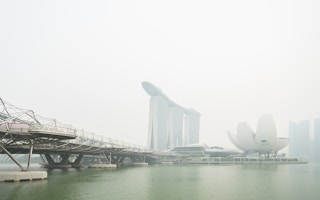Engrossed in Singapore’s general election last week, many residents in the city-state hardly remarked on the city’s steadily worsening air quality brought about by raging forest fires in neighbouring Indonesia.
To continue reading, subscribe to Eco‑Business.
There's something for everyone. We offer a range of subscription plans.
- Access our stories and receive our Insights Weekly newsletter with the free EB Member plan.
- Unlock unlimited access to our content and archive with EB Circle.
- Publish your content with EB Premium.
Then last Thursday - Cooling-off Day in Singapore - everyone paused for a breather from the hustings and realised, well, that breathing was not quite so easy.
The three-hour Pollutant Standards Index (PSI), which tracks air quality, hit a high of 248 at 3am last Friday.
All across pockets of Singapore, Malaysia and Indonesia, the haze triggered flight delays, health warnings and cancellations of outdoor events. It was a stark reminder of the persistent nature of the problem, which remains unresolved despite several so-called breakthroughs by both the public and private sectors in addressing it.
The annual haze is caused by the illegal slash-and-burn agricultural practices of Indonesian farmers, who favour it as the quickest and cheapest way of clearing plantations for oil palm, paper and other crops. Carbon-rich, waterlogged peatlands are also often drained in this process, leaving behind highly flammable matter that is difficult to put out once it catches fire.
The onset of El Nino, a climate phenomenon involving long spells of hot and dry weather, has only exacerbated the problem.
In June 2013, these fires were so severe they resulted in record-breaking levels of air pollution in Singapore and a state of emergency in towns in Malaysia and Indonesia.
This triggered a series of responses to the haze. Environmental groups like Greenpeace targeted companies in the forest supply chain in high-profile campaigns. As a result, many of these Singapore-based firms - such as Wilmar International, Golden Agri Resources, and Asia Pulp and Paper - made landmark commitments to stop deforestation and to hold their suppliers to the same standards.
Industry groups such as the Roundtable on Sustainable Palm Oil raised standards for their certification process.
On the governmental front, Singapore passed the Transboundary Haze Bill which allows it to penalise errant companies that cause haze. Indonesia ratified the Association of South-east Asian Nations Agreement on Transboundary Haze Pollution, some 12 years after its launch.
Last December, Indonesian President Joko Widodo promised to restore forest peatlands and hold companies that cleared forests accountable.
Despite these efforts, the haze problem persists because its systemic causes are not being addressed.
“
Singapore will no doubt regain its clear blue skies when the wind changes direction, but it is clear that the region needs to coordinate and reconsider its strategy.
Indonesia is a central protagonist and holds the key to the solution, but, in many of its efforts, it has been a case of one step forward, two steps back.
Take, for instance, the interlinked issues of transparency, land use information and law enforcement. For decades, there has been a lack of transparency when it comes to maps on land ownership. Without a centralised, public map, the task of pinpointing errant companies or landowners is a murky affair.
To address this, Indonesia has embarked on the One Map Initiative - a comprehensive map of land ownership to provide clarity on the exact boundaries of land owned by companies, communities and the government - which is to be completed in two to three years’ time. This effort must be accelerated.
Experts have also noted that even as the government works on this One Map, it has been reluctant to make its existing concession maps publicly available to public forest-monitoring platforms such as the World Resources Institute’s Global Forest Watch. If Indonesia is serious about tackling the haze issue, it must release data that will facilitate public monitoring.
The other issue is law enforcement. In the past few decades, officials have either been too relaxed in prosecuting those responsible for starting fires - or been bribed not to do so. This needs to change.
There have been some encouraging signals under Mr Joko, with 10 plantation companies reportedly under investigation for intentional burning.
But one other related concern is that the regional community may be looking in the wrong place. While recent attention has largely focused on the behaviour of large companies - and rightly so, as they own large swathes of forest land - there is an increasing body of evidence that points to small- to mid-scale farmers as equally culpable.
Reports in the Jakarta Globe point to studies showing that in Sumatra and Kalimantan, 59 per cent and 73 per cent of fire emissions originate from outside timber and oil-palm concession boundaries respectively. These farmers fly under the radar, are immune to any big campaign by non-governmental organisations, and lie outside the influence of industry groups.
It is obvious that efforts to tackle the haze must also shift towards addressing this group, by implementing local initiatives that incentivise these farmers to manage their land with non-burning methods, among other things.
Encouragingly, the civic sector seems to have been shifting its campaigning efforts to address other players in the forest supply chain.
The World Wide Fund for Nature (WWF), for example, launched a new report in May that targets financial institutions in Singapore, Malaysia and Indonesia for their role in the region’s haze and deforestation problems.
The report revealed that a large number of banks in these countries - including Singapore’s DBS, OCBC and UOB - perform poorly when it comes to applying environmental, social and governance standards to the companies that they make loans to. This means that they are indirectly financing deforestation and, as a result, the haze.
In July, WWF Singapore, the People’s Movement to Stop Haze and the Singapore Institute of International Affairs launched the country’s first public campaign to tackle the haze, focusing their efforts on the consumer.
The campaign, “We Breathe What We Buy”, seeks to educate buyers about the palm oil used widely in products - from lipstick to toothpaste and ice cream - through outreach programmes, ad placements, school talks and art installations.
The ultimate goal is to get people to buy products only from companies that use certified sustainable palm oil, and trigger a change further up the supply chain to get farmers and landowners to operate responsibly.
Singapore will no doubt regain its clear blue skies when the wind changes direction, but it is clear that the region needs to coordinate and reconsider its strategy.
And we must keep at it, regardless of clear skies or not, if there is to be any hope for a long-lasting solution.
A version of this column was originally published in The Straits Times.











